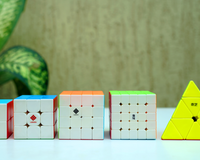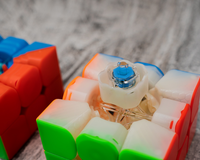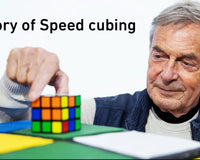Introduction
This blog will be a basic overview of the concept of rNISS, a technique used in the event of 3x3 FMC. Insertions are one of the most important tools you can use in an FMC attempt. When I was first learning about these concepts, I struggled with the traditional way of discovering insertions within the given time. Then, I found the concept of rNISS, an alternative and complementary method for finding the best insertions that has helped me to this day.
What are Insertions?
In FMC, once you have a “skeleton”, the cube will mostly be solved except for a few pieces that need to be moved around to their correct places. Insertions are sets of moves inserted into the skeleton so that they solve those pieces and cancel out as many moves as possible in the process. This way, the final solution will be much more efficient than just solving the cube directly.

The Traditional Way: Stickers
The usual way to find insertions would be to first label each of the pieces using numbered stickers to show the order in which the pieces must be swapped. Then, you slowly go through each move of the skeleton from the cube’s scrambled state and note down any insertion that can cancel the most number of moves.
rNISS
rNISS stands for reverse NISS, a method to find and visualize insertions by taking advantage of the cyclical nature of the scramble and solution. In this method, you first choose a point in the skeleton that you want to check for insertions. Then, you perform the moves of the skeleton after that point, then perform the scramble, then perform the moves of the skeleton before that point. This will leave you with the rest of the cube solved, and only those specific pieces unsolved, which you can then find a solution for easily.
For an example, let us say the scramble is R’ U’ F D2 B2 F’ U R and the skeleton is D F L2 B’ R2 F U2. You want to now visualize how the unsolved pieces will be between the F and L2 position in the skeleton. So you perform L2 B’ R2 F U2, then the scramble, and then D F, to give you that specific position.

Advantages of rNISS
I found that the traditional method took a lot of time to analyze each of the stickered pieces against the jumbled rest of the cube. Visually, it was harder to make out how exactly the pieces should be moved around. The advantage of rNISS is that it gives you a very clear visual image of the position, since the rest of the cube is solved. Hence, it is easier to find a possible insertion. Another advantage is in cases where a lot of pieces need to be solved using insertions, like having 4 corners and 5 edges, for example. rNISS allows you to look at this jumbled and hard position at each point in the skeleton clearly. It allows for using many unorthodox insertions besides the common 3 cycles. You can even insert single moves or R U R’ U’ if that solves the most pieces efficiently.
check out our Skewb collection
Conclusion
I have found rNISS to be a very useful tool to find, visualize, and verify a large number of insertions in a quick and easy to understand way. This method is especially useful if you are fast at scrambling, so it will take much less time than using stickers for many cases. Hopefully this blog has given you a general idea of this method so that you can implement it in your own FMC toolkit.
About Author

Pranav Prabhu
Pranav Prabhu is the current 3x3 Fewest Moves (Single) National record holder from Chennai. He started cubing when he was 14 and has 5 years of cubing experience. Besides cubing, Pranav enjoys reading books, writing, and playing the piano. He has participated in 36 competitions and won 30 podiums including 8 gold medals and 1 National record






























